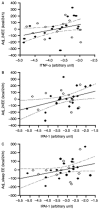Circulating white blood cell count and measures of adipose tissue inflammation predict higher 24-h energy expenditure
- PMID: 19934269
- PMCID: PMC4793713
- DOI: 10.1530/EJE-09-0831
Circulating white blood cell count and measures of adipose tissue inflammation predict higher 24-h energy expenditure
Abstract
Objective: Energy expenditure (EE) and measures of inflammation increase with adiposity, and this obesity-induced chronic and subclinical inflammation was extensively reported to be a cause of insulin resistance. However, whether subclinical inflammation has a role in increasing EE, which may be at the cost of developing insulin resistance, is not clear.
Methods: We investigated the association between circulating white blood cell count (WBC) in a population of Native Americans (n=243) with measurement of EE in a respiratory chamber, and in a subset of the same population (n=34), with gene expression measures of inflammation in subcutaneous abdominal adipose tissue (SAAT). All subjects were healthy on oral glucose tolerance test. Statistically, nonnormally distributed variables were logarithmically transformed before analyses to approximate normal distributions.
Results: WBC was associated with 24-h EE adjusted for age, sex, fat-free mass, and fat mass (r=0.13, P=0.04). In SAAT, tumor necrosis factor-alpha (TNF-alpha), shown as log10-transformed TNF-alpha (r=0.36, P=0.05), and plasminogen activator inhibitor-1 (PAI-1), shown as log10-transformed PAI-1 (lPAI-1; r=0.41, P=0.02), expressions were also positively correlated with adjusted 24-h EE. lPAI-1 was also correlated with adjusted sleep EE (r=0.34, P=0.07).
Conclusions: In conclusion, circulating markers of inflammation (WBC) and markers of inflammation within adipose tissue (TNF-alpha and PAI-1) are positively associated with EE, indicating a role of chronic subclinical inflammation in the regulation of metabolic rate.
Conflict of interest statement
Figures


Similar articles
-
Macrophage content in subcutaneous adipose tissue: associations with adiposity, age, inflammatory markers, and whole-body insulin action in healthy Pima Indians.Diabetes. 2009 Feb;58(2):385-93. doi: 10.2337/db08-0536. Epub 2008 Nov 13. Diabetes. 2009. PMID: 19008342 Free PMC article.
-
Plasminogen activator inhibitor 1, transforming growth factor-beta1, and BMI are closely associated in human adipose tissue during morbid obesity.Diabetes. 2000 Aug;49(8):1374-80. doi: 10.2337/diabetes.49.8.1374. Diabetes. 2000. PMID: 10923640
-
Determinants of energy expenditure and fuel utilization in man: effects of body composition, age, sex, ethnicity and glucose tolerance in 916 subjects.Int J Obes Relat Metab Disord. 1999 Jul;23(7):715-22. doi: 10.1038/sj.ijo.0800910. Int J Obes Relat Metab Disord. 1999. PMID: 10454105
-
Release of interleukins and other inflammatory cytokines by human adipose tissue is enhanced in obesity and primarily due to the nonfat cells.Vitam Horm. 2006;74:443-77. doi: 10.1016/S0083-6729(06)74018-3. Vitam Horm. 2006. PMID: 17027526 Review.
-
The contribution of different adipose tissue depots to plasma plasminogen activator inhibitor-1 (PAI-1) levels.Blood Rev. 2016 Nov;30(6):421-429. doi: 10.1016/j.blre.2016.05.002. Epub 2016 May 19. Blood Rev. 2016. PMID: 27233154 Review.
Cited by
-
White blood cell count predicts the odds of kidney function decline in a Chinese community-based population.BMC Nephrol. 2017 Jun 7;18(1):190. doi: 10.1186/s12882-017-0608-4. BMC Nephrol. 2017. PMID: 28592280 Free PMC article.
-
Adipose tissue inflammation in glucose metabolism.Rev Endocr Metab Disord. 2014 Mar;15(1):31-44. doi: 10.1007/s11154-013-9274-4. Rev Endocr Metab Disord. 2014. PMID: 24048715 Review.
-
Metabolically healthy obesity: Inflammatory biomarkers and adipokines in elderly population.PLoS One. 2022 Jun 9;17(6):e0265362. doi: 10.1371/journal.pone.0265362. eCollection 2022. PLoS One. 2022. PMID: 35679338 Free PMC article.
-
Metabolic basis of ethnic differences in diabetes risk in overweight and obese youth.Curr Diab Rep. 2014 Feb;14(2):455. doi: 10.1007/s11892-013-0455-z. Curr Diab Rep. 2014. PMID: 24445905 Free PMC article. Review.
-
Relationship between Depression with Physical Activity and Obesity in Older Diabetes Patients: Inflammation as a Mediator.Nutrients. 2022 Oct 9;14(19):4200. doi: 10.3390/nu14194200. Nutrients. 2022. PMID: 36235852 Free PMC article.
References
-
- Hotamisligil GS, Shargill NS, Spiegelman BM. Adipose expression of tumor necrosis factor-alpha: direct role in obesity-linked insulin resistance. Science. 1993;259:87–91. - PubMed
-
- Grimble RF. Inflammatory status and insulin resistance. Current Opinion in Clinical Nutrition and Metabolic Care. 2002;5:551–559. - PubMed
-
- Bouchard L, Mauriege P, Vohl MC, Bouchard C, Perusse L. Plasminogen-activator inhibitor-1 polymorphisms are associated with obesity and fat distribution in the Quebec Family Study: evidence of interactions with menopause. Menopause. 2005;12:136–143. - PubMed
-
- Argiles JM, Lopez-Soriano J, Busquets S, Lopez-Soriano FJ. Journey from cachexia to obesity by TNF. FASEB Journal. 1997;11:743–751. - PubMed
Publication types
MeSH terms
Substances
Grants and funding
LinkOut - more resources
Full Text Sources
Medical
Miscellaneous

